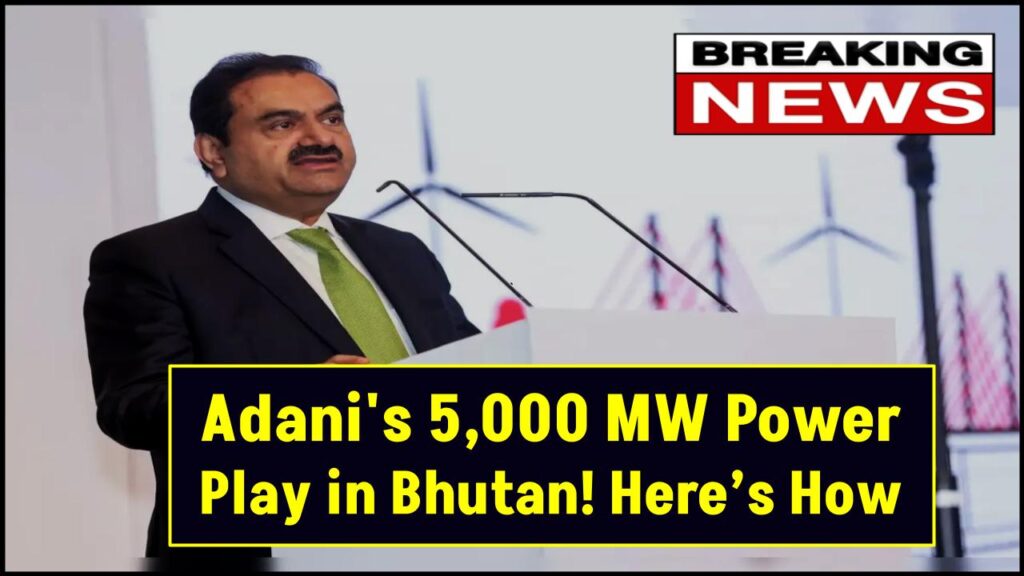Adani’s Bold Bet Outside India: Adani Group, one of India’s largest multinational conglomerates, has made a significant move to expand its clean energy footprint outside India by signing a Memorandum of Understanding (MoU) with Bhutan’s Druk Green Power Corporation (DGPC). This ambitious 5,000 megawatt (MW) hydropower project could redefine regional power dynamics and bolster energy security in South Asia. In this article, we’ll break down why this deal is a game-changer for both India and Bhutan.

Adani’s Bold Bet Outside India
| Key Aspect | Details |
|---|---|
| Project Size | 5,000 MW Hydropower |
| Location | Bhutan |
| Partners | Adani Group (India), Druk Green Power Corporation (DGPC) (Bhutan) |
| Economic Impact | Job creation, infrastructure development, long-term economic growth |
| Environmental Benefits | Clean, renewable energy, reduced carbon emissions |
| Strategic Importance | Energy security, regional cooperation, economic stability |
| Expected Completion | By 2040 (aligned with Bhutan’s Renewable Energy Roadmap) |
| Reference | Economic Times Article |
Adani’s bold move to invest in Bhutan’s hydropower potential is a significant step toward regional energy integration, economic growth, and environmental sustainability. By leveraging Bhutan’s natural resources, this 5,000 MW deal promises to redefine the energy landscape of South Asia, creating a win-win for both countries.
Why Adani Chose Bhutan for This Major Energy Project
1. Bhutan’s Untapped Hydropower Potential
Bhutan, often referred to as the “Land of the Thunder Dragon,” is known for its pristine natural landscapes and abundant hydropower resources. With fast-flowing rivers descending from the Himalayas, Bhutan has an estimated hydropower potential of around 30,000 MW, of which only a fraction has been harnessed. This makes Bhutan an ideal location for large-scale hydropower projects.
2. A Strategic Move for Regional Energy Security
Adani’s investment aligns with India’s broader strategy to reduce its carbon footprint while ensuring energy security. Importing clean, renewable hydropower from Bhutan helps India diversify its energy sources, reducing reliance on fossil fuels and strengthening its energy grid.
3. Economic and Diplomatic Benefits
This partnership goes beyond just power generation. It strengthens the economic and diplomatic ties between India and Bhutan, reinforcing a long-standing relationship built on mutual trust and cooperation. The deal is also expected to generate significant economic benefits for Bhutan through job creation, infrastructure development, and increased energy exports.
The Economic Impact of the 5,000 MW Deal
Job Creation and Local Economic Growth
Large-scale infrastructure projects like this hydropower deal are known for their potential to create thousands of jobs, both directly and indirectly. From construction to operations and maintenance, the economic ripple effects are substantial, providing long-term stability and growth for Bhutan’s economy.
Infrastructure Development
The project will require extensive infrastructure, including dams, power stations, and transmission lines. This infrastructure investment can spur further economic growth, improve connectivity, and enhance overall living standards in Bhutan.
Revenue from Energy Exports
Once operational, the 5,000 MW project will generate significant revenue for Bhutan through energy exports to India, creating a stable source of national income.
Environmental and Strategic Benefits
Clean, Renewable Energy
Hydropower is one of the cleanest sources of energy, producing no direct emissions and significantly reducing the carbon footprint compared to fossil fuels. This aligns perfectly with Bhutan’s ambitious goal to remain carbon-negative and support global climate change mitigation efforts.
Strengthening Bilateral Relations
This collaboration is a powerful symbol of the strong diplomatic ties between India and Bhutan, setting a precedent for future cross-border energy partnerships in South Asia.
FAQs on Adani’s Bold Bet Outside India
Q: What is the main benefit of the Adani-DGPC partnership for Bhutan?
A: The partnership offers Bhutan economic growth, job creation, and long-term financial stability through energy exports.
Q: How will this deal impact India’s energy sector?
A: It helps India diversify its energy sources, reduce carbon emissions, and strengthen its energy security.
Q: When will the project be completed?
A: The project is expected to align with Bhutan’s Renewable Energy Roadmap, targeting full capacity by 2040.





